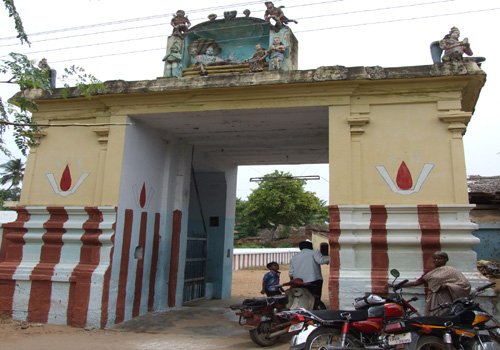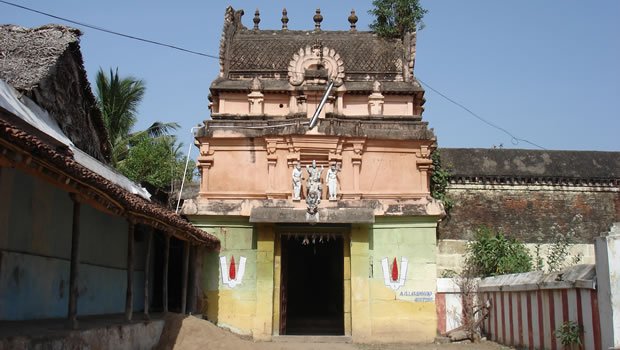Gajendra Varadha Perumal Temple in Thirukkavithalam is dedicated to the Hindu god Maha Vishnu. The temple is glorified in the Divya Prabandha, the early medieval Tamil canon of the Azhwar saints from the 6th?9th centuries AD. It is one of the 108 Divyadesam dedicated to Vishnu, who is worshipped as Gajendra Varadha and his consort Lakshmi as Ramamanivalli. The temple is one of the five Pancha-Kannan temples, where Krishna, an avatar of Vishnu is given prominence over the presiding deity.
Shrine’s History
The temple is believed to have been built by the Medieval Cholas of the late 8th century AD, with later contributions from Vijayanagar kings and Madurai Nayaks. A granite wall surrounds the temple, enclosing all its shrines and its bodies of water.

Legends Associated with This Shrine
As per Hindu legend, King Indrajuman, who immersed himself in the worship of Lord Vishnu, failed to strengthen his army and lost his kingdom. While doing worship, he also did not observe the sage Durvasa who went along his way. The sage got irritated and cursed the king to be born as an elephant in his next birth. The king apologised to the sage for his negligence and moved by his innocence, the sage wished that he would continue to be a Vishnu devotee as an elephant and that Vishnu would bestow his goodwill. There was a demon by name Koohoo in the temple tank at this place, who troubled all who took the bath in the tank. He was cursed by a sage to be born as the crocodile in his next birth.
The elephant Gajendra continued as a Vishnu devotee and while drinking water from the temple tank, his leg was grabbed the crocodile. The elephant cried in rescue calling the name “Adimulam” and Vishnu sent his discus to fend off the crocodile. Both the elephant and crocodile turned to their human form by the grace of Vishnu. Since Vishnu appeared heard of saving the elephant Gajendra, he came to be known as Gajendra Varadar. Hanuman, the monkey lieutenant of Rama, also worshiped Vishnu at this place and hence the place came to be known as Kabisthalam

Architectural Relevance of This Shrine
A brick wall surrounds the temple,enclosing all its shrines and bodies of water. The temple has a five-tier rajagopuram and a single precinct. The prime deity, Gajendra Varadhar is enshrined in the sactum,in a reclining posture, called Bhujanga sayanam. The vimana is called Ganganakrutha Vimanam.There is a separate shrine for Ramanavalli, located to the right of the sanctum. There are separate shrines for Yoga Narasimhar, Sudarsana,Garuda and the Azhwars in the first sanctum.
Shrine’s Map Location and How to Go There
By Road
Thanjavur is well connected with Chennai, Coimbatore, Tiruchirapalli, Karaikal, Madurai, Tirunelveli, Kumbakonam, Pattukkottai, Bangalore, Ernakulam, Marthandam, Nagercoil, Tirupathi, Thiruvananthapuram, Ooty and Mysore through regular bus services.
By Rail
Thanjavur railway station is an important railway junction of Southern Railways. Thanjavur is connected by rail with most important CITIES and towns in India like Chennai, Bangalore, Mysore, Ernakulam, Thrissur, Palakkad, Coimbatore, Erode, Tirupur, Tiruchirapalli, Salem, Karur, Madurai, Tirunelveli, Rameswaram, Tiruchendur, Karaikal, Dharmapuri and weekly trains to Vishakapatnam, Tirupati, Vijayawada, Goa, Vizianagaram, Nagpur, Jabalpur, Allahabad, Varanasi, Bhubaneshwar and to all main cities.
By Air
The nearest INTERNATIONAL Airport is the Tiruchirapalli International Airport which is about 50 km from the city.
Shrine Timings
7 A.M to 8 P.M
Events Celebrated at This Shrine
Gajendra Moksha Leela July or August
Chariot festival May or June
Brahmmotsavam May or June
Chithirai April or May
Extra Information About this Shrine
Nearby Temple
Agastheeswarar Temple
Kasinathaswami Temple
Tennazhagar Temple
Krishnaswami Temple
Neelamaninathaswami Temple













































